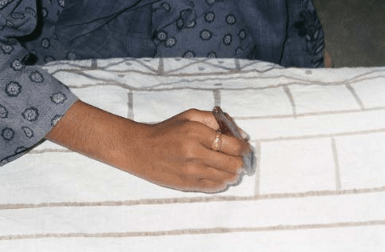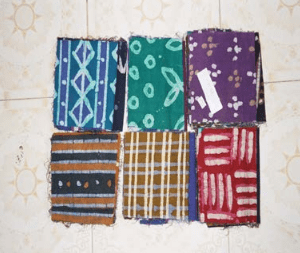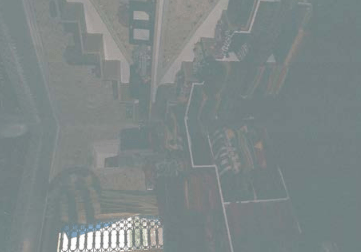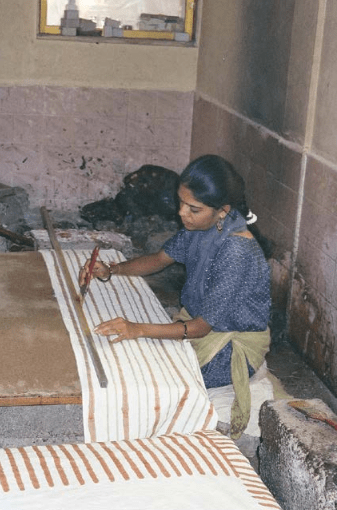BATIK ART Dying Method
Batik, an art which originated in India, has come a long way from being a mere handicraft. The word batik actually means ‘wax writing’. It is a way of decorating cloth by covering a part of it with a coat of wax and then dyeing the cloth.
The waxed areas keep their original color and when the wax is removed the contrast between the dyed and undyed areas makes the pattern.
The beauty of batik lies in its simplicity and the fact that one need not be an artist to achieve results. Some of the best effects in batik are often achieved by chance. The history of Indian batik can be traced as far back as 2000 years.
Indians were conversant with the resist method of printing designs on cotton fabrics long before any other nation had even tried it. Rice starch and wax were initially used for printing on fabrics. It is believed that after initial popularity of batik in the past, the tedious process of dyeing and waxing caused the decline of batik in India till recent times.
Batik is very often considered a craft like ceramics, pottery or even needlework. Although it is a household word all over the world, it is still overlooked by art critics who do not consider it an art form. There are several countries known for their batik creations, starting with India where it originated. After that it moved to Indonesia, Malaysia, Sri Lanka, Thailand and the West.
BATIK: Regions of Dying Method
The revival of batik in India began in the 20th century when it was introduced as a subject at the famous University of Shantiniketan in Kolkata. In the south, near Chennai, the well-known artist’s village of Chola-Mandal is where batik gets an artistic touch. Batik that is produced in Chennai is known for its original and vibrant designs.
Batik printing is done in:
Gujarat: Block and Hand Batik
Rajasthan:
Block and Hand Batik
Kolkata
Andhra Pradesh: Kalamkari Batik
Maharashtra
Madhya Pradesh
Batik printing can be done anywhere but each area and region has its own specialty in designs and colors.
Producer communities of batic
In present times batik printing is not associated with any particular caste or community. Earlier, in Gujarat though only Khatri caste was involved in the craft but now people have taken batik printing as a source of livelihood like any other skill.
Raw Material batic
i)Cotton or silk cloth is used for batik (synthetic materials are generally not used).

ii)Paraffin wax is used in the process.
iii)Dyes – Napthol, Direct and Vat dyes are all used in the dyeing process
iv)Firewood and kerosene for heating the wax
Paraffin wax before use and after it has been used twice
Cotton cloth for wax printing and dyeing is bought from the south (Tamil Nadu). Dyes are available in Jamnagar, Anjar-Gujarat and Mumbai.Vat dyes have more color fastness but have a limited color range. They are the most expensive. Napthol dyes are used more for dark base colors like maroon and blue. Direct dyes are used more for over dyeing after the pattern and the other colors have been done.
Availability: All the raw material required for batik is easily available though it is difficult to find some of the old block designs that were used earlier for printing.
Tools of batic
i)Wooden blocks for printing

ii)Vessel to heat wax in
iii)Plastic bucket or big bowls to mix colors
iv)A frame/ table to fix the cloth (table has sand on it so the wax does not spread)
v)Brushes for making free-hand designs. These brushes can be used only for waxing.
Making of the Craft batic
Batik’s true origins are a mystery. The word (pronounced bateek) is translated in many different ways—some sources say it means ‘to dot’; some translate it as ‘wax writing’ or ‘drawing with a broken line’.
Batikis the art of waxing a surface, usually cloth, to make it resist dyeing, and then removing the wax, re-waxing, re-dyeing and creating intricate patterns and designs. It is a very old form of art, as evidence of early batik has been found all over the Middle East as well as India and Central Asia from about 2000 years ago.
In very true batik, wax is painstakingly applied to the cloth to resist successive dyes so that wherever the cloth is waxed, dyes cannot penetrate.
Applying wax on to the cloth, wax is kept in a container next to the printing table.
For example, if the desired design is a red flower on a blue background, wax is first applied to the area that will become the flower. The white cloth is then immersed in blue dye and dried. After dyeing, the wax, which covered the flower pattern, is scraped off the cloth.
Because the wax resisted the blue dye, there is now a white flower on a blue background. To make the flower red, the blue background is covered with wax and the entire cloth is immersed in red dye. When the wax is scraped off the cloth for a second time, a red flower emerges on a blue background.
This process is repeated over and over again as more colors are used. The finest batik is reversible; motifs are drawn, waxed and dyed first on one and then the other side of the fabric.
The creation of batik is a three-stage process of waxing, dyeing and de-waxing (removing the wax). There are also several sub-processes like preparing the cloth, tracing the designs, stretching the cloth on to the frame, waxing the area of the cloth that does not need dyeing, preparing the dye, dipping the cloth into the dye, boiling the cloth to remove the wax and washing the cloth with soap.
The characteristic effects of batik are the fine cracks that appear in the wax, which allow small amounts of the dye to seep in. It is a feature not possible in any other form of printing. It is very important to achieve the right type of cracks or hairline details for which the cloth must be crumpled correctly. This requires a lot of practice and patience.
Knowing how to use the wax is of prime importance. The ideal mixture for batik wax is 30 percent beeswax and 70 per cent paraffin wax (but these days mostly paraffin wax is used as it is easily available and less costly). It is the skillful cracking that is important.
While applying, the wax should not be overheated or it will catch fire. Correct knowledge of colors is also important. Practicing on small pieces of cloth helps in the beginning.
The cloth used should be strong enough to bear the heat and wax. Cambric, poplin and voiles are used besides pure silk. Synthetic fabrics are avoided. Along with handmade batik, blocks are also used for wax printing. Blocks are usually made of wood or metal and often used during the printing process.
Batik is created in several ways. In the splash method, the wax is splashed or poured on to the cloth. The screen-printing method involves a stencil. The hand-painting one is by a Kalamkari pen. The scratch and starch resist are the other methods.
The process in brief:
Step 1: Cotton fabric is bleached (with bleaching powder and water) and kept overnight for whiteness. This process is done by machine or manually.
Step 2: Wax printing is done either with the hand, using a brush or with the blocks (paraffin wax is melted and kept on the stove right next to the printer).
Wax Printing with brush
The table on which printing is done is kept cool with sand and water so that the wax does not spread and the design stays consistent throughout.
Step 3: After the initial printing, the fabric is dipped in a color fixer.
Stacked waxed fabric with design
Step 4: The fabric is then dipped in napthol dye (say red) for 10-15 minutes.
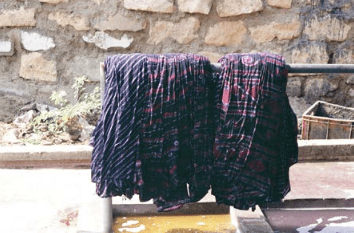
Step 5: If only a single color is required, then after this the cloth can be dipped in hot water so that the wax comes off and one gets the required pattern and color.
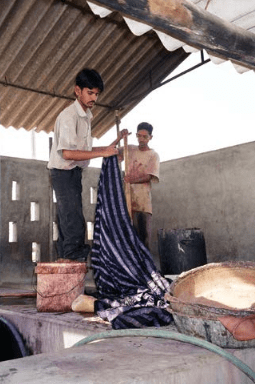
Step 6: If any white spots are left and one doesn’t want that, then the fabric could be dipped once more in any direct dye (say yellow). This process is called ‘topping’.
Step 7: If one wants more patterns and colors, reprinting could be done with wax and the whole process is repeated again.
Batic Products and Their Uses
Batik is a textile art similar to tie and dye. Instead of tying the fabric, however, wax is applied to resist dyes. The wax can be removed and re-applied several times to make beautiful and intricate designs. The striking beauty of batik bedspreads, curtains, tablecloths and placemats is indescribable.
The colors are so vivid and the designs so stunning that it’s hard to believe they were made with wax and dye. The batik industry is still very much alive today. Although it is common to see the mass production of batik with machines, it is still made by hand in many parts of the world. There is a considerable market for this high – quality cloth.
Perhaps batik is still popular today because of its artistic freedom. The designs become whatever the artist’s heart desires. Batik is very durable: it has more color fastness than printed fabrics because through the dyeing process the fabric absorbs the color so well that it does not easily fade.
The batik technique first started out as a decoration for royals. Today, the striking and intricate patterns can be seen on the ramp, in the office and on formal occasions. Designers have recently started incorporating batik into everyday clothing, not only in Asian countries, but all around the world!
Batic Primary Market
From a handicraft, batik has acquired the status of an art. Batik is a versatile medium that can become an ideal hobby for an amateur or a medium of expression for an artist. As an art form it is quite spontaneous and one can open up new vistas of creative form.
Until recently, batik was made for dresses and tailored garments only but modern batik is livelier and brighter in the form of murals, wall hangings, paintings, household linen and scarves.
It has been introduced in many areas as a source of income generation where there isn’t a sustainable source of livelihood. The market has increased in the last decade and there is more product diversification and one can see batik on clothes, home furnishings, fabric and paintings.
Beads and mirrors are also added to the fabric to give it a more decorative look.
Sales are good in metros like Mumbai, Bangalore and Delhi and other cities like Baroda and Ahmadabad.
The Gujarat state emporium, Gurjari, also stocks the fabric and is a regular buyer. Either the fabric/products are sold directly at the exhibition or they are supplied to wholesalers and retailers in the market.
There is year-round demand for the fabric. Export for batik has also increased in the last decade as it has been exported to United Kingdom, Japan and United States.
Development or Changes in the Craft over the Years
People are again demanding the old designs or the blocks that were used earlier.
The demand has increased for old intricate designs. There are improved facilities now for waxing, bleaching and washing the fabric. The process is less cumbersome and easy to learn for those who are doing it for the first time.










